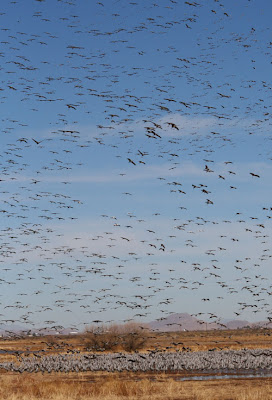 |
| A male Eared Quetzal with a madrone berry near Madera, Chihuahua, Mexico |
These globally-rare relatives of the Elegant Trogon and Resplendent Quetzal are extremely rare and secretive inhabitants of southeastern Arizona's "sky island" mountain ranges. Though they aren't known to undertake long-distance migrations, several years often pass between sightings.
The last reports of this species in Madera Canyon were from late October through mid-November of 2007. The quetzal was elusive, but vigilant quetzal seekers found other unusual to rare species in the same area (the Patagonia Picnic Table Effect). Andrew Core summarized some of these sightings on his blog, using Google Earth to create highly detailed maps.
Since Eared Quetzals are both greatly sought-after and highly sensitive to human presence, here are a few tips that may make the difference between success and failure for would-be quetzal watchers (updated from posts to BirdChat in December 1999 and BIRDWG05 in 2005):
- Dress in muted, natural colors right down to your shoes, socks and hat. Browns, mid-tone grays, tans, and natural greens are all okay, but avoid white and very light pastels, bright colors, and light blues such as faded denim. If your wardrobe doesn't include any camo, muted plaids and checks are the next best thing.
- Eared Quetzals are more often heard than seen, so prepare by studying recordings of the bird's calls ahead of time. Xeno-canto has three samples: the first includes the tremolo (a territorial song) and squeal-chucks, the second is mainly tremolo, and the third is mainly squeal-chucks plus a distant flight cackle (and the raspy calls of Steller's Jays). Be aware that the most commonly heard calls—the squeal-chuck and the flight cackle—are signs of alarm. If you hear either of these calls, chances are the bird has seen you and/or another observer and is in evasive mode. Chasing a frightened quetzal is counterproductive. The best strategy is to freeze in place until the bird calms down.
- In areas where the bird has been sighted, move slowly and as little as possible, stay in the shadows, and keep noise to a minimum. The best strategy is to pick a likely spot, especially near a fruiting madrone (a broad-leafed tree with scaly gray bark and bright red berries), and sit as still as possible in the shade of a nearby tree. Eared Quetzals are extremely stealthy for their size and can fly in quite close to you without you realizing it, so any sudden moves or sounds may result in lost viewing opportunities for yourself and others.
- Eared Quetzals are very active feeders, plucking fruit on the wing. If the bird approaches a position near a fruiting tree but remains out of sight, be patient - you'll likely have several viewing opportunities once it feels comfortable enough to feed. If you feel you must move to get a look at the bird, do so slowly and quietly, staying as concealed as possible behind vegetation and out of bright sunlight.
- Prepare for a long wait by dressing in layers, wearing sunscreen on exposed skin, and bringing water and snacks. I guarantee that a good look at this exquisite and globally rare bird is more than worth it.

UPDATE 1/7/11:







